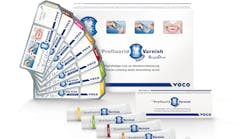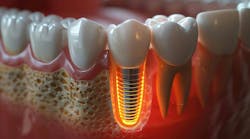The varnish gap: Closing the prevention divide in moderate to high-risk adults
What you'll learn in this article
- Nearly 90% of US adults experience tooth decay, highlighting the urgent need for preventive dental education.
- Acidic beverages, medications, and weak saliva buffering increase caries risk, requiring tailored patient prevention strategies.
- Profluorid Varnish delivers time-released fluoride, calcium, and phosphate, strengthening enamel and reducing tooth sensitivity.
- Patient education must address fluoride controversies, emphasizing evidence-based benefits over misinformation from social media sources.
- Preventive hygiene visits should integrate technology, personalized care, and fluoride varnish to improve compliance and long-term oral health.
Nearly 90% of US adults aged 20 to 64 have experienced tooth decay.1 A notable factor is that working adults tend to have the highest caries prevalence across all age groups. Contributing factors such as xerostomia-inducing medications, acidic beverages such as seltzer water, sugar-free sports drinks, and even bottled waters drop the pH below the critical point of 5.5.
Some mouths have a strong buffering capacity, but others stay acidic longer, creating an environment where caries and periodontal pathogens thrive. Here I hope to shift the perspective of the current education in your hygiene department—offering a global view of how we approach educating patients to prevent hard tissue disease, our role in caries prevention, and the foundational aspects of identifying the root cause of the imbalance to help support the microbiome.
Addressing the controversy
Social media has changed the way patients are educated, and it’s led to many patients becoming concerned about using fluoride in prevention. This is an opportunity for the team to educate them about the difference between topical and systemic fluoride applications. It’s also helpful to let patients know that most of the studies that show negative effects of fluorides are tested using 10 to 20 times the amount of fluoride that’s in our in water.
Benefits of Profluorid Varnish
Profluorid Varnish is a 5% sodium fluoride varnish that has 22,600 ppm of fluoride in a colophony-based varnish. The varnish works to rapidly seal dental tubules by coating the tooth with the fluoride and calcium ions, which contribute to the formation of fluorapatite. In addition to the fluoride, calcium, and phosphate, the varnish also offers xylitol that serves as a cariostatic effect and improves the taste.
The formulation offers a time-released fluoride over several hours. The first 15 minutes after application, approximately half the fluoride is released. At the one-hour mark, nearly double the fluoride is absorbed, and the Profluorid continues to work up to four hours post-application.2 This allows the varnish treatment to continue to work after the patient leaves the office. The great tasting flavors increase patient compliance to keep it on the teeth for a longer duration.2 It’s available in seven flavors, including caramel, mint, melon, and pina colada.
How you present this to patients
The preventive philosophy in the hygiene practice needs to be calibrated so the hygiene team not only knows how to educate, but also how to handle patient objections. Many patients arrive with fears, such as pain, costs, time and—the biggest factor negating patient compliance in my opinion—no perceived need.
The entire appointment should include multiple experiences showing the patient evidence of the hard and soft tissue diseases or risks they present with. Patients want to know that we’re making customized recommendations specifically for their mouth based on their medical history, factors of their compliance, diet, and disease-indicating factors that they can help combat or reduce.
This is where the amazing technology that dentistry offers can come into play—intraoral scanners, intraoral cameras, salivary testing, disclosing agents, and of course, the patient mirror. Taking two minutes to explain what the disclosing reveals or showing the difference between a healthy area of tissue versus diseased tissue creates an impactful experience for most patients. I say “most” because not all patients are ready to take ownership of their disease. However, it’s our job to educate them with kindness and empathy to help lead them to a yes.
I personally like to describe the Profluorid Varnish like this: “I recommend that we treat you today with a fluoride varnish due to your specific risks of (insert risk: sensitivity, clinical attachment loss, risk of decay). This is formulated with fluoride as well as calcium and phosphate, minerals found naturally in the tooth. This will help reduce your risk of tooth decay, which can cause your composite restorations.
“It’s designed to work for up to four hours, without feeling sticky. The flavors are also fantastic. It’s not covered by your insurance, as most dental insurance serves simply as a discount card, but that does not change the benefits fluoride varnish can offer.”
If we assume the patient will say no, then that will be the outcome. Every patient deserves the opportunity to choose technologies that will support their oral health.
We’re in uncharted territory, with the US seeing movements toward removing fluoride from public water systems. Utah was the first state to ban it, followed by Florida. Now more than ever, it is crucial for dental professionals to prioritize effective biofilm removal and educate patients on evidence-based preventive solutions.
The Profluorid Varnish gives a solution for moderate to high-risk patients to prevent hypersensitivity and offer future caries protection. Therefore, this fast-setting technology should be considered as a core offering in preventive hygiene visits.
Editor's note: This article appeared in the August/September 2025 print edition of RDH magazine. Dental hygienists in North America are eligible for a complimentary print subscription. Sign up here.
References
1. Oral Health in America - April 2022 Bulletin. National Institute of Dental and Craniofacial Research. Last reviewed July 2024. https://www.nidcr.nih.gov/research/oralhealthinamerica/section-3a-summary
2. VOCO Profluorid Varnish. VOCO Dental. https://www.voco.dental/cn/portaldata/1/resources/products/folders/gb/voco-profluorid-varnish_fol_gb.pdf#:~:text=5%20,formation%20of%20fluorapatite%20in%20the
About the Author

Amber Auger, MPH, RDH
Amber is a dental hygiene clinician, international speaker, and hygiene director who specializes in nonsurgical periodontal therapy, heart-centered education, and efficiency. Through her signature program, Thrive in the OP and Thrive Chairside Summit, she equips hygienists with evidence-based systems to elevate patient outcomes, confidence, and production. Amber blends clinical expertise with practical strategies to help dental teams implement sustainable, science-driven protocols. She can be reached at amberauger.com.


